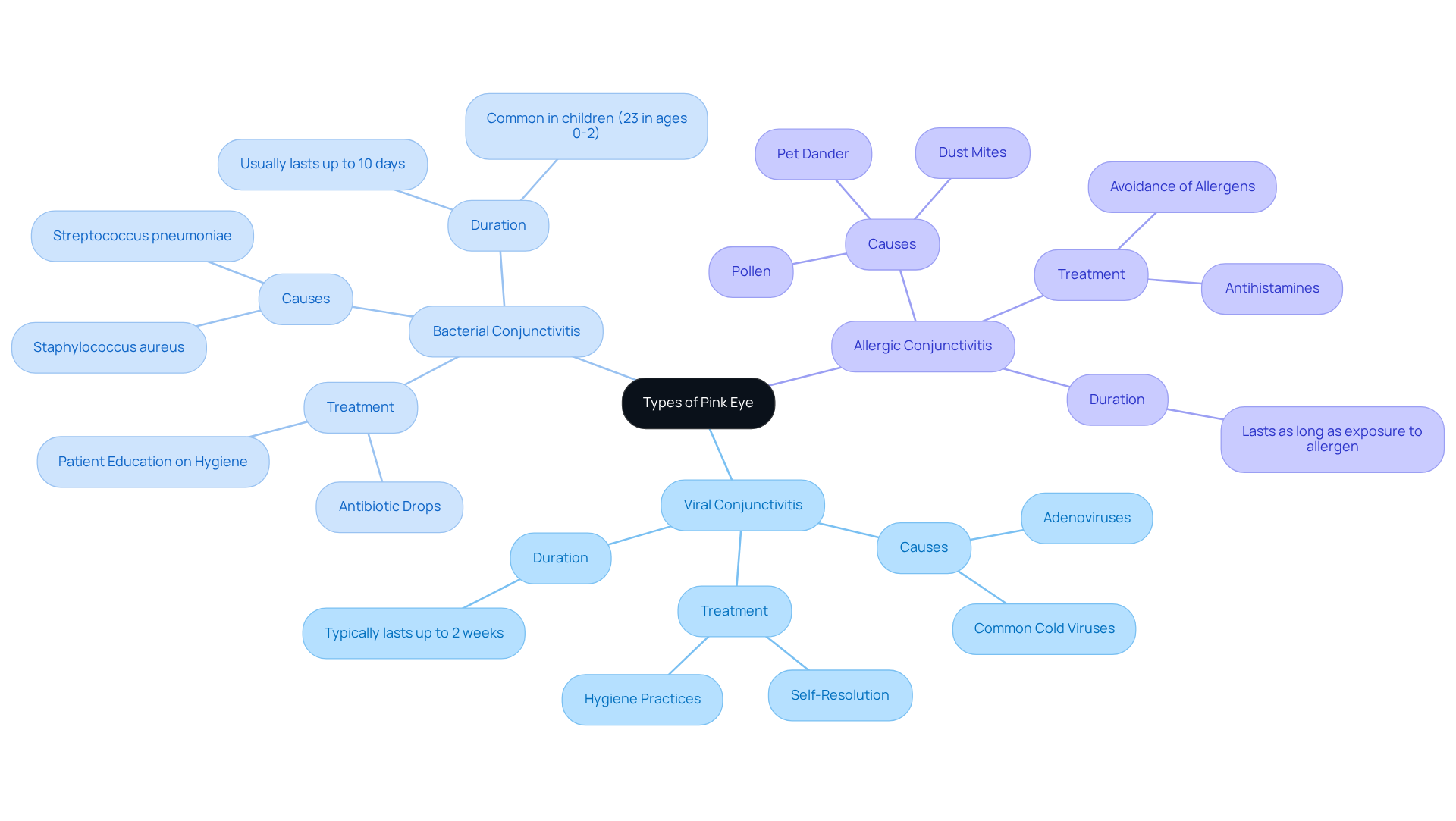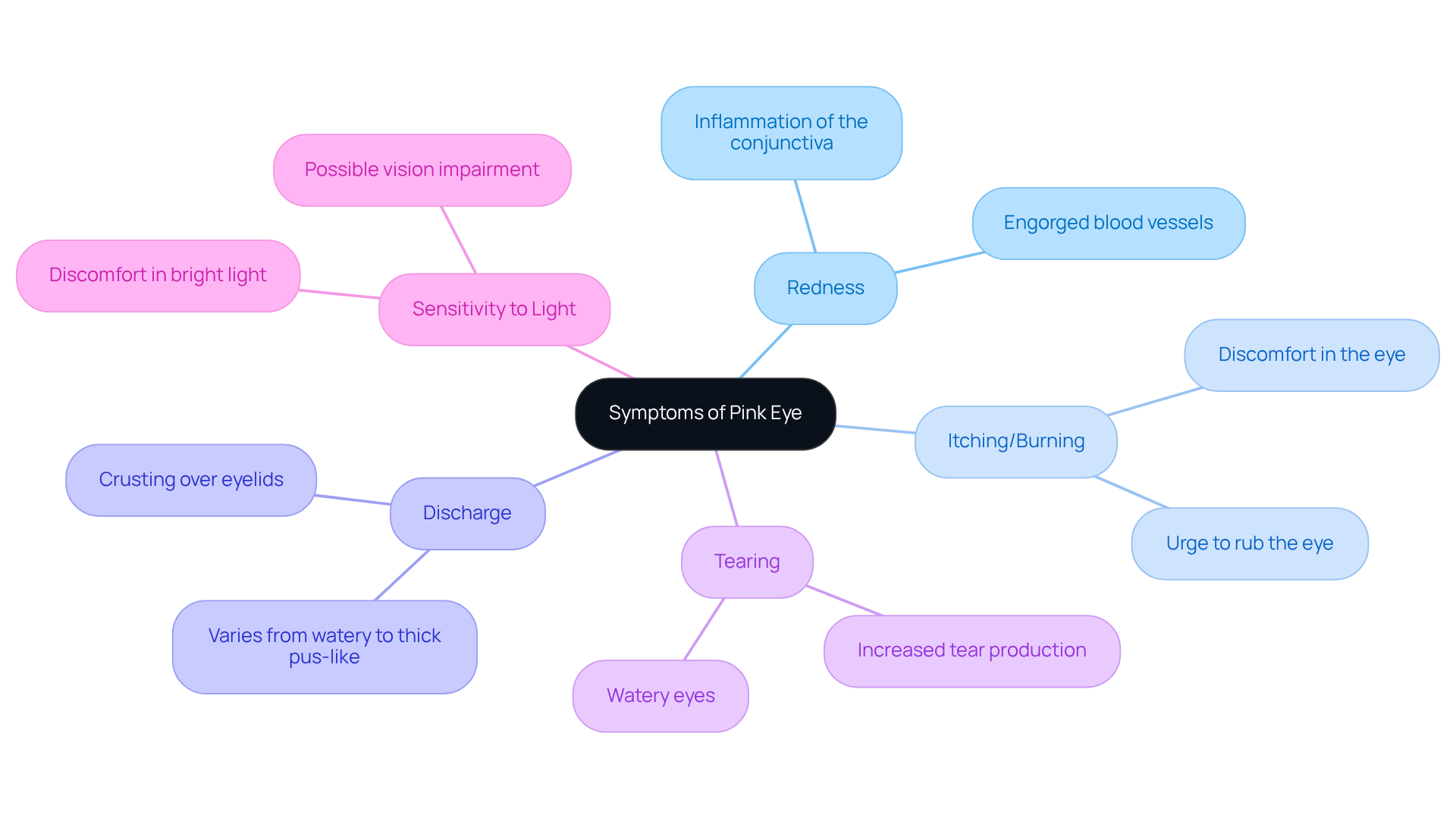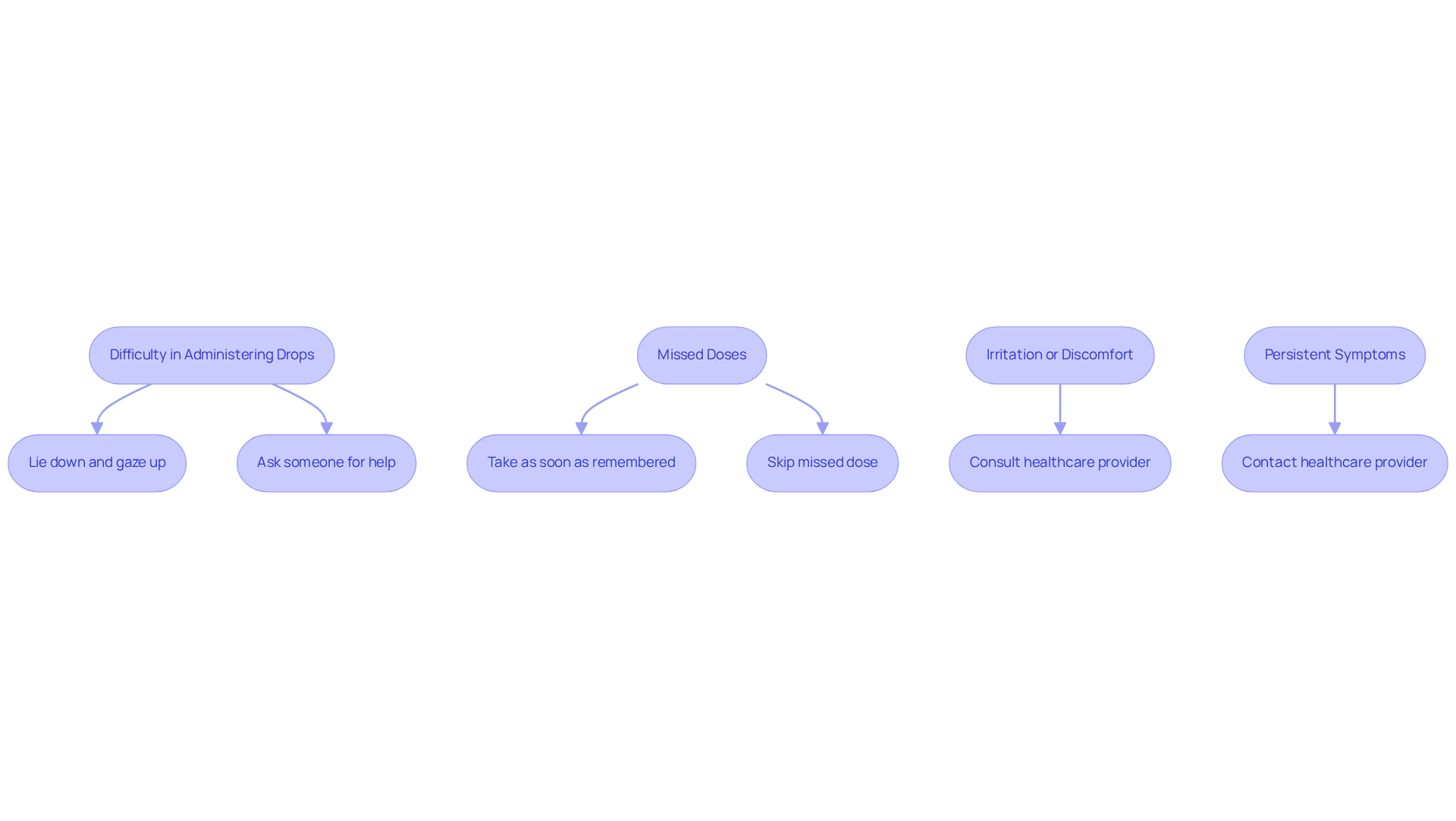Posted by: Northwest Eye in General on October 28, 2025
Overview
The article titled “Master Pink Eye Antibiotic Drops: Steps for Effective Use” focuses on the proper administration of antibiotic drops for treating bacterial conjunctivitis. We understand that dealing with eye infections can be stressful, and it’s important to know that you’re not alone in this. This article emphasizes the importance of following specific steps—such as handwashing, correct positioning, and timing—to enhance treatment effectiveness and minimize complications.
It’s common to feel overwhelmed when managing your health, but adhering to these practices can significantly improve your health outcomes. Evidence supports that taking these steps not only helps in your recovery but also provides peace of mind. Remember, we are here to help you through this process, ensuring you feel supported every step of the way.
Introduction
Understanding the intricacies of pink eye, or conjunctivitis, is vital for effective treatment and prevention. We understand that facing this condition can be concerning, and knowing the different types—viral, bacterial, and allergic—each presenting unique challenges, is essential for managing symptoms effectively.
It’s common to feel overwhelmed when it comes to utilizing antibiotic drops, but mastering their application can significantly impact your recovery and comfort. Many individuals encounter difficulties in administering these drops correctly, leading to frustration and potential complications.
We are here to help you through this process. How can one master the application of pink eye antibiotic drops to ensure optimal healing and comfort? Let’s explore this together.
Understand Pink Eye: Types and Causes
Pink eye, or conjunctivitis, is a common concern that many people face, and understanding its types can help you feel more in control. There are three primary types, each with distinct causes and treatment approaches:
-
Viral Conjunctivitis: This highly contagious form is often caused by viruses associated with the common cold, such as adenoviruses. We understand that it can be worrisome, but the good news is that it typically resolves on its own within two weeks. However, it spreads easily from person to person, so it’s important to be mindful of hygiene.
-
Bacterial Conjunctivitis: Resulting from bacterial infections, this type often necessitates pink eye antibiotic drops for effective treatment. Common pathogens include Staphylococcus aureus and Streptococcus pneumoniae. It’s common to feel anxious about bacterial infections, especially since they can be transmitted through direct contact with infected individuals or contaminated surfaces. This type is particularly prevalent among children, with 23% of cases occurring in those aged 0-2 years. Most cases resolve within 1-2 weeks, especially when treated appropriately.
-
Allergic Conjunctivitis: Triggered by allergens such as pollen, dust mites, or pet dander, this non-contagious type can be managed effectively with antihistamines or other allergy medications. We know that dealing with allergies can be frustrating, and the length of allergic eye inflammation often correlates with exposure to the allergen, persisting as long as the individual is in contact with the trigger.
Comprehending these categories is essential for recognizing the suitable care and deciding when to pursue medical guidance. For example, while viral eye infections may not need specific treatment, bacterial eye infections often benefit from prompt use of pink eye antibiotic drops to avoid complications. Furthermore, patient education on hygiene practices is crucial in decreasing the spread of bacterial eye infections, especially among contact lens wearers, who are at heightened risk for infections. By identifying the signs and indicators of each type, you can take proactive measures toward effective management and recovery. We are here to help you through this process.

Identify Symptoms of Pink Eye
Common symptoms of pink eye, or conjunctivitis, include:
- Redness: The white part of the eye appears pink or red due to inflammation.
- Itching or Burning: We understand that discomfort can be quite bothersome.
- Discharge: This may vary from watery to thick pus-like consistency, often crusting over the eyelids, particularly after sleep.
- Tearing: Increased tear production is frequently observed.
- Sensitivity to Light: It’s common to feel discomfort in bright light conditions.
Pink eye can result from viruses, bacteria, or allergens, making it crucial to comprehend the context of these signs. Significantly, recent reports indicate that COVID-19 can also lead to eye inflammation, which adds another layer of consideration for patient care protocols at Northwest Eye. Our scheduling team will consider this when evaluating conditions.
It is important to note that pink eye antibiotic drops are often necessary because pink eye is highly contagious, especially in its viral and bacterial forms. Studies show that nearly 6 million individuals in the U.S. are impacted by bacterial eye infections each year, often treated with pink eye antibiotic drops, with signs frequently beginning in one eye before possibly extending to the other. Most cases of conjunctivitis do not require pink eye antibiotic drops, as viral conjunctivitis typically resolves on its own.
If you are encountering these symptoms, we encourage you to steer clear of close interaction with others and seek advice from a healthcare professional for a precise diagnosis and to discuss suitable options, such as pink eye antibiotic drops. We are here to help you through this process.

Administer Antibiotic Drops Correctly
To ensure effective administration of antibiotic drops, we want to guide you through the following steps with care:
- Wash Your Hands: Begin by thoroughly washing your hands with soap and water to prevent contamination. We understand that cleanliness is crucial in this process.
- Prepare the Medication: If necessary, gently shake the bottle and remove the cap without touching the dropper tip. This step helps ensure that the drops are ready for you.
- Tilt Your Head Back: Look up at the ceiling to create a pocket in your lower eyelid. It’s common to feel a bit awkward here, but it’s an important part of the process.
- Administer the Drops: Hold the dropper above your eye and squeeze the prescribed number of drops into the pocket formed by your lower eyelid. Be careful not to let the dropper touch your eye or eyelid. We know this can be a little nerve-wracking, but you’re doing great.
- Close Your Eye: After administering the drops, gently close your eye for about a minute. This helps facilitate absorption of the medication, and it’s a moment to take a deep breath.
- Wipe Away Excess: Use a clean tissue to wipe away any excess liquid that may have spilled out. This keeps things tidy and comfortable.
- Wash Your Hands Again: Finally, wash your hands once more to eliminate any medication residue. This is an important step in keeping you safe.
Repeat this process as directed by your healthcare provider.
Statistics suggest that appropriate management techniques greatly improve patient compliance. Research demonstrates that following these steps can enhance health outcomes. Ophthalmologists emphasize the importance of these best practices, highlighting that the effective use of pink eye antibiotic drops is crucial for managing conditions like pink eye. Following these guidelines not only aids in recovery but also minimizes the risk of complications. Remember, we are here to help you through this process.

Troubleshoot Common Issues with Antibiotic Drops
Common issues with pink eye antibiotic drops can occur, and we understand that addressing them effectively can significantly improve your care experience. Here are some key points to consider:
- Difficulty in Administering Drops: We recognize that it can be challenging to keep your eye open or steady. If you’re finding it hard, try lying down and gazing up at the ceiling. Alternatively, you might ask someone you trust to assist you in administering the drops.
- Missed Doses: It’s common to forget a dose. If this happens, take it as soon as you remember. However, if it’s nearly time for your next dose, skip the missed one and resume your regular schedule. Remember, avoid doubling up on doses.
- Irritation or Discomfort: If you experience irritation or discomfort after using the pink eye antibiotic drops, please consult your healthcare provider. They may suggest a different formulation or additional measures to ease your discomfort.
- Persistent Symptoms: If your symptoms do not improve within a few days of beginning care, we encourage you to contact your healthcare provider for further evaluation.
By proactively addressing these common issues, you can facilitate a smoother treatment process and achieve better outcomes. We are here to help you through this process.

Conclusion
Understanding the complexities of pink eye, or conjunctivitis, is crucial for effective management and treatment. We understand that dealing with this condition can be concerning, and recognizing the different types of pink eye—viral, bacterial, and allergic—along with their distinct causes and treatment methods is essential. Each type presents unique challenges and requires specific care strategies, especially in the case of bacterial conjunctivitis, where the timely use of antibiotic drops is often essential.
Key insights include identifying symptoms such as:
- Redness
- Itching
- Discharge
These can guide you in seeking appropriate medical advice. Additionally, we’ve outlined the step-by-step process for administering antibiotic drops correctly, emphasizing hygiene and proper technique to enhance treatment effectiveness. Addressing common issues related to drop administration, such as missed doses or discomfort, further equips you with the knowledge to navigate your treatment journey successfully.
In conclusion, mastering the use of pink eye antibiotic drops is not just about applying medication; it involves understanding the condition, recognizing symptoms, and adhering to best practices for administration. By being informed and proactive, you can significantly improve your recovery and minimize the risk of complications. It’s common to feel uncertain, but it is essential to remain vigilant and consult healthcare professionals for any persistent symptoms or concerns. We are here to help you through this process, ensuring a comprehensive approach to your eye health.
Frequently Asked Questions
What is pink eye and what are its types?
Pink eye, or conjunctivitis, is a common eye concern characterized by inflammation of the conjunctiva. There are three primary types: viral conjunctivitis, bacterial conjunctivitis, and allergic conjunctivitis, each with distinct causes and treatment approaches.
What causes viral conjunctivitis and how is it treated?
Viral conjunctivitis is often caused by viruses associated with the common cold, such as adenoviruses. It is highly contagious but typically resolves on its own within two weeks, and no specific treatment is usually required.
What is bacterial conjunctivitis and what are its treatment options?
Bacterial conjunctivitis results from bacterial infections and often requires antibiotic drops for effective treatment. Common pathogens include Staphylococcus aureus and Streptococcus pneumoniae. Most cases resolve within 1-2 weeks when treated appropriately.
How does allergic conjunctivitis differ from other types?
Allergic conjunctivitis is triggered by allergens like pollen, dust mites, or pet dander. It is non-contagious and can be managed with antihistamines or other allergy medications. The duration of symptoms often depends on exposure to the allergen.
Why is understanding the types of pink eye important?
Understanding the types of pink eye is essential for recognizing the appropriate care and deciding when to seek medical guidance. Different types require different treatments, and knowing the signs can help in effective management and recovery.
How can the spread of bacterial conjunctivitis be minimized?
Patient education on hygiene practices is crucial in decreasing the spread of bacterial eye infections, especially among contact lens wearers, who are at an increased risk for infections.
What is the prevalence of bacterial conjunctivitis in children?
Bacterial conjunctivitis is particularly prevalent among children, with 23% of cases occurring in those aged 0-2 years.






